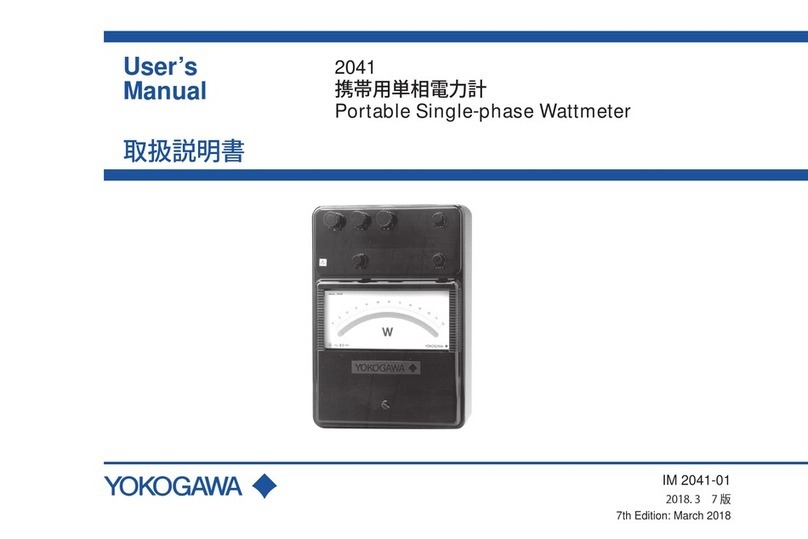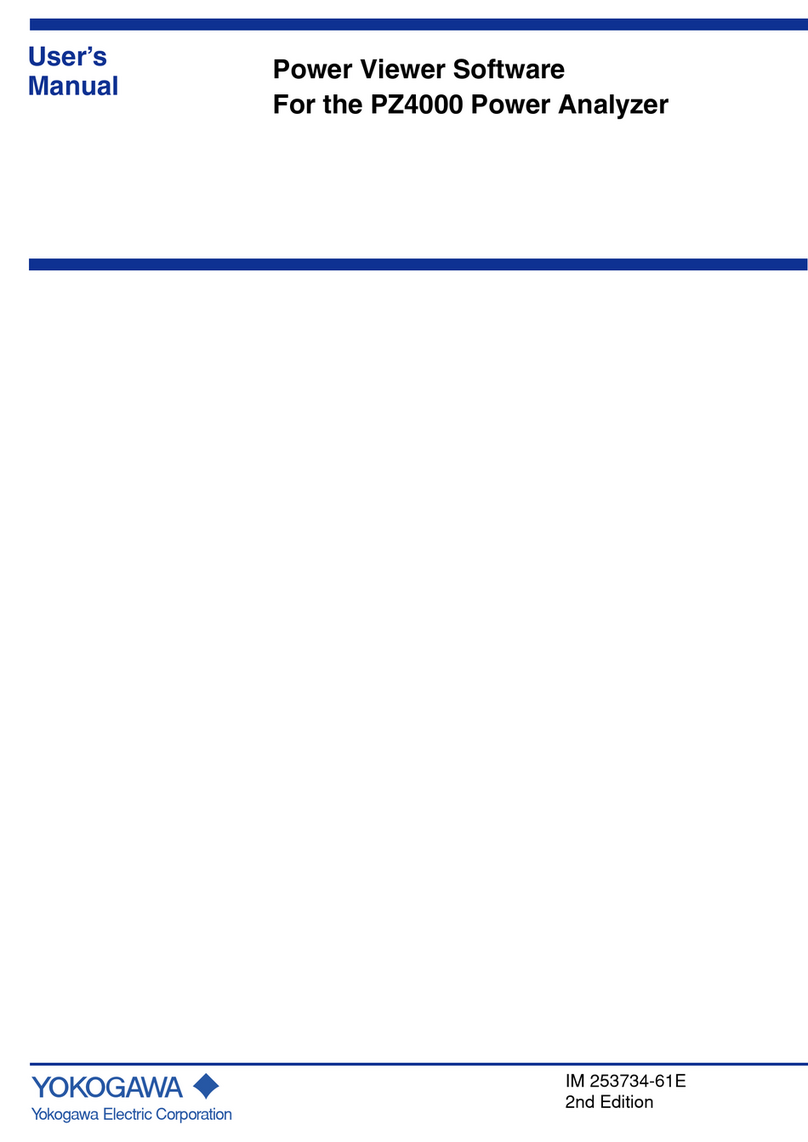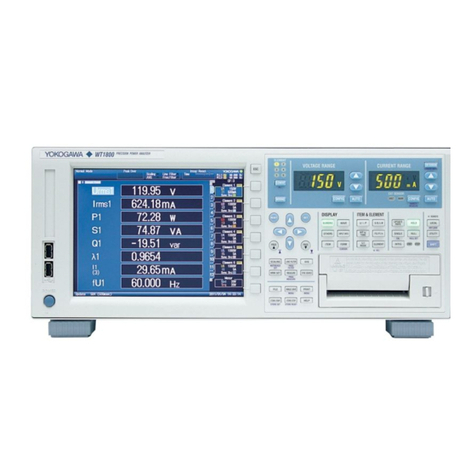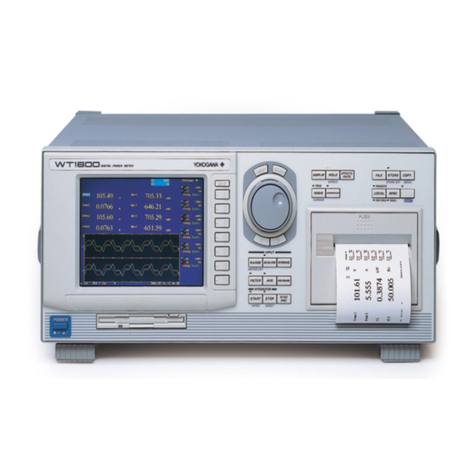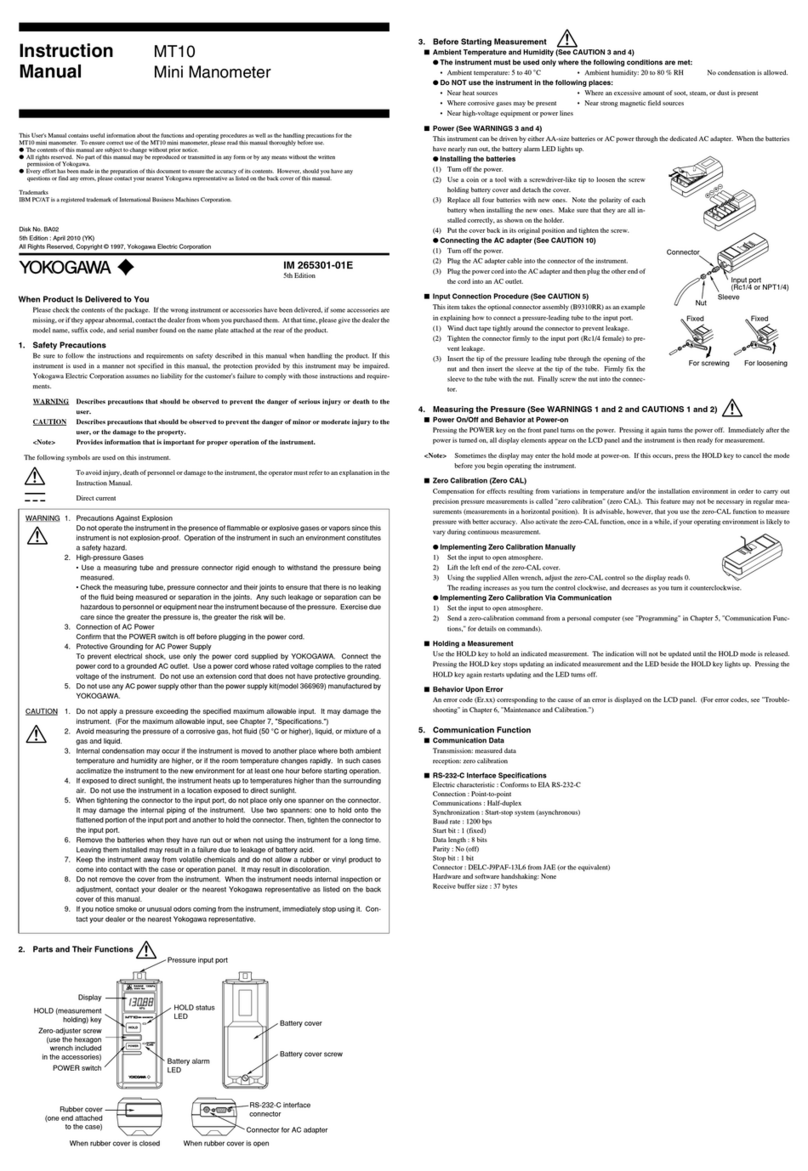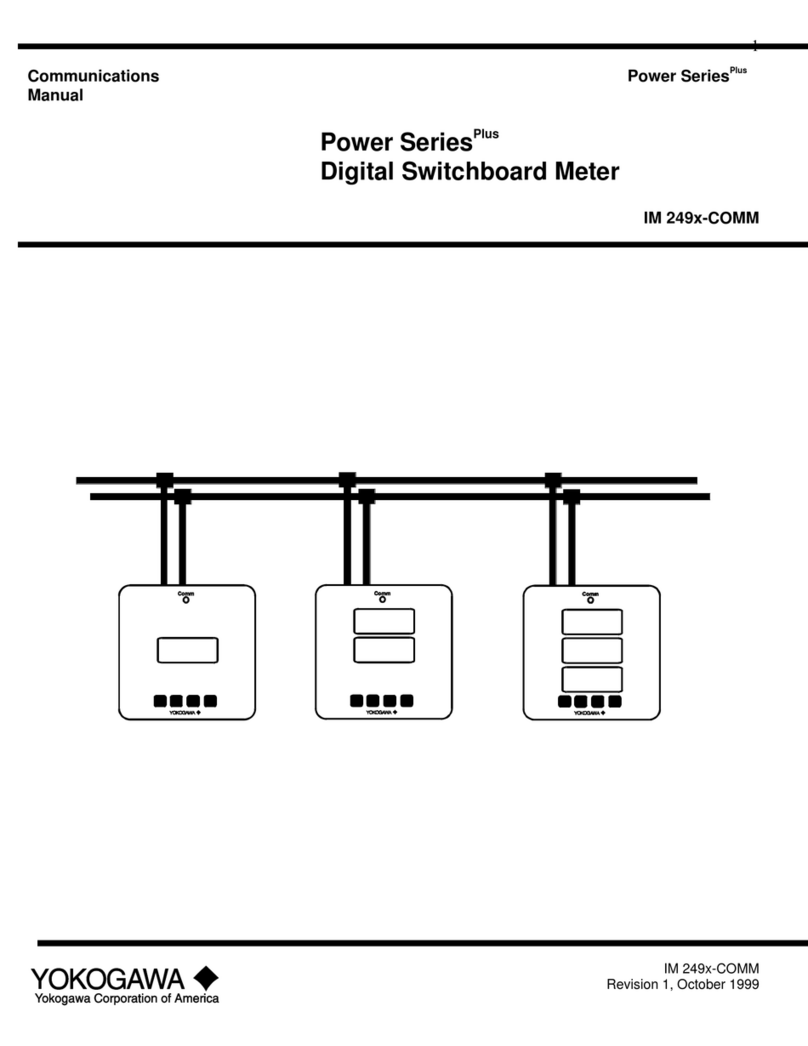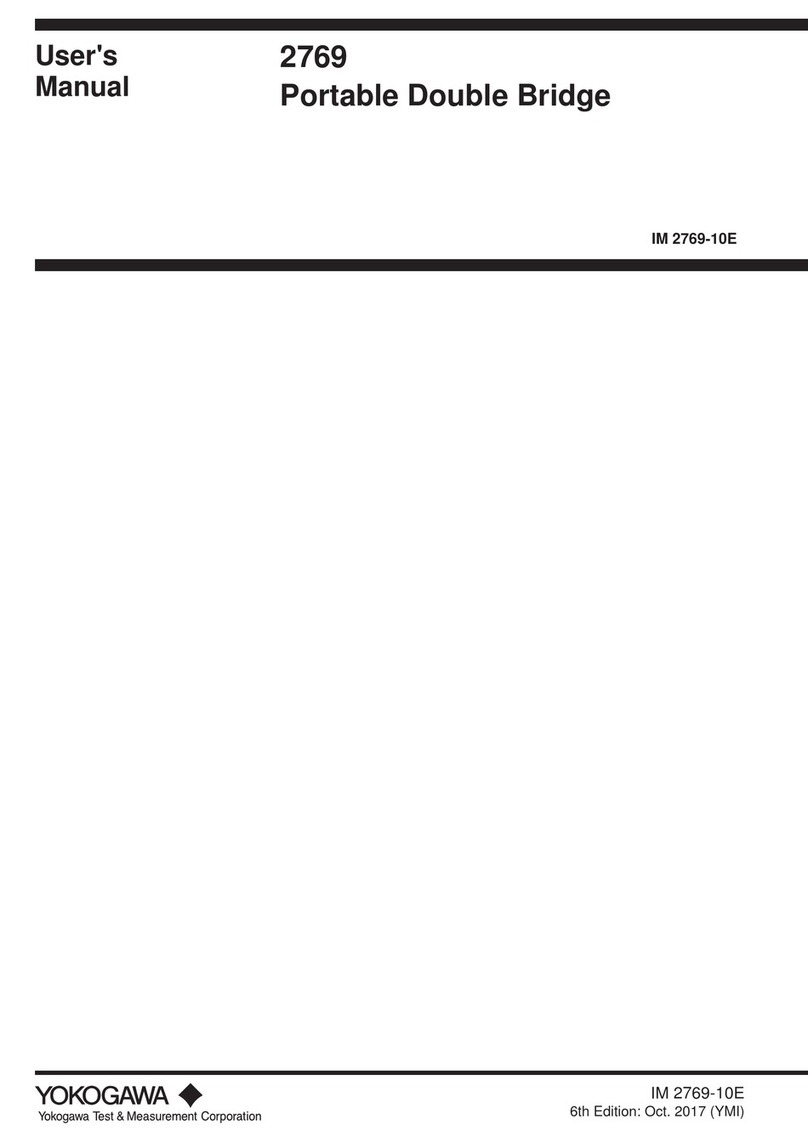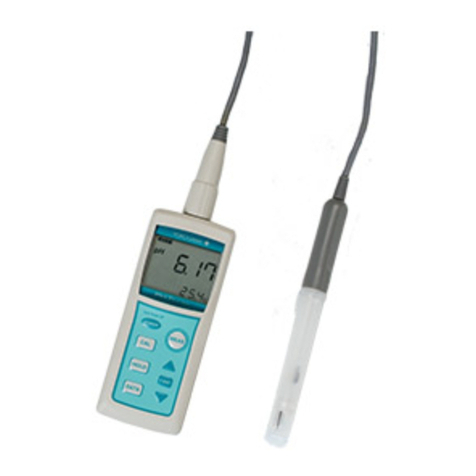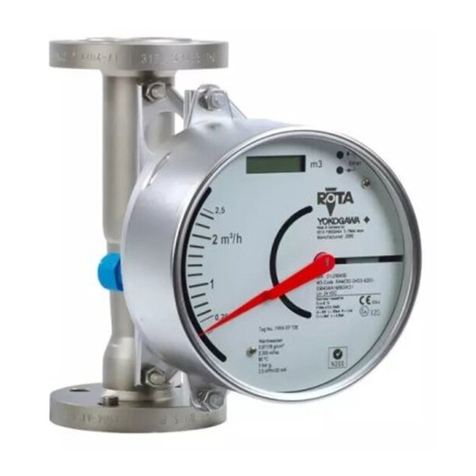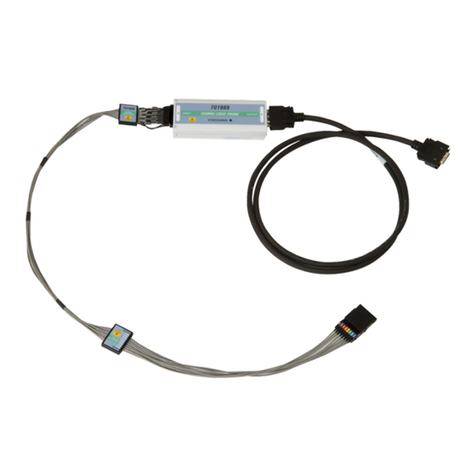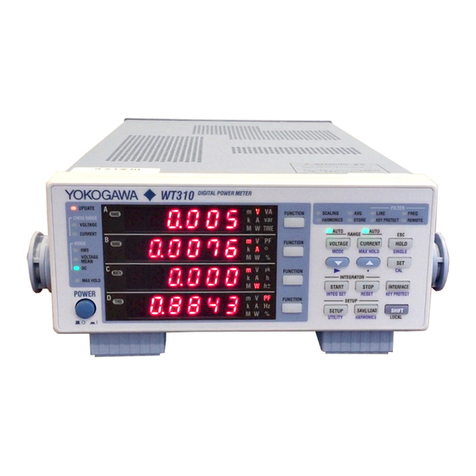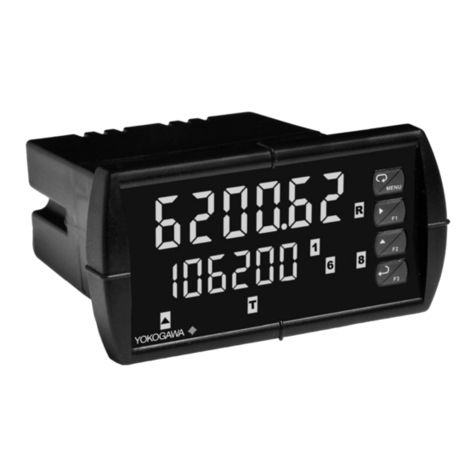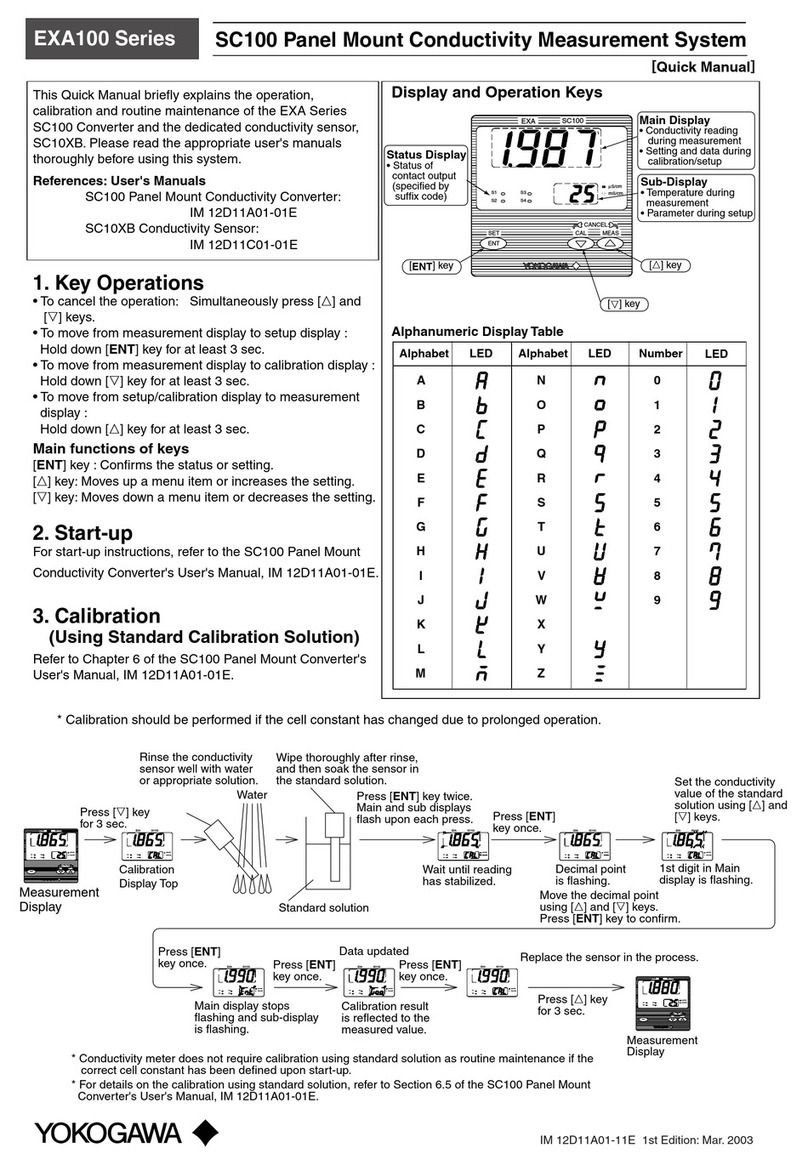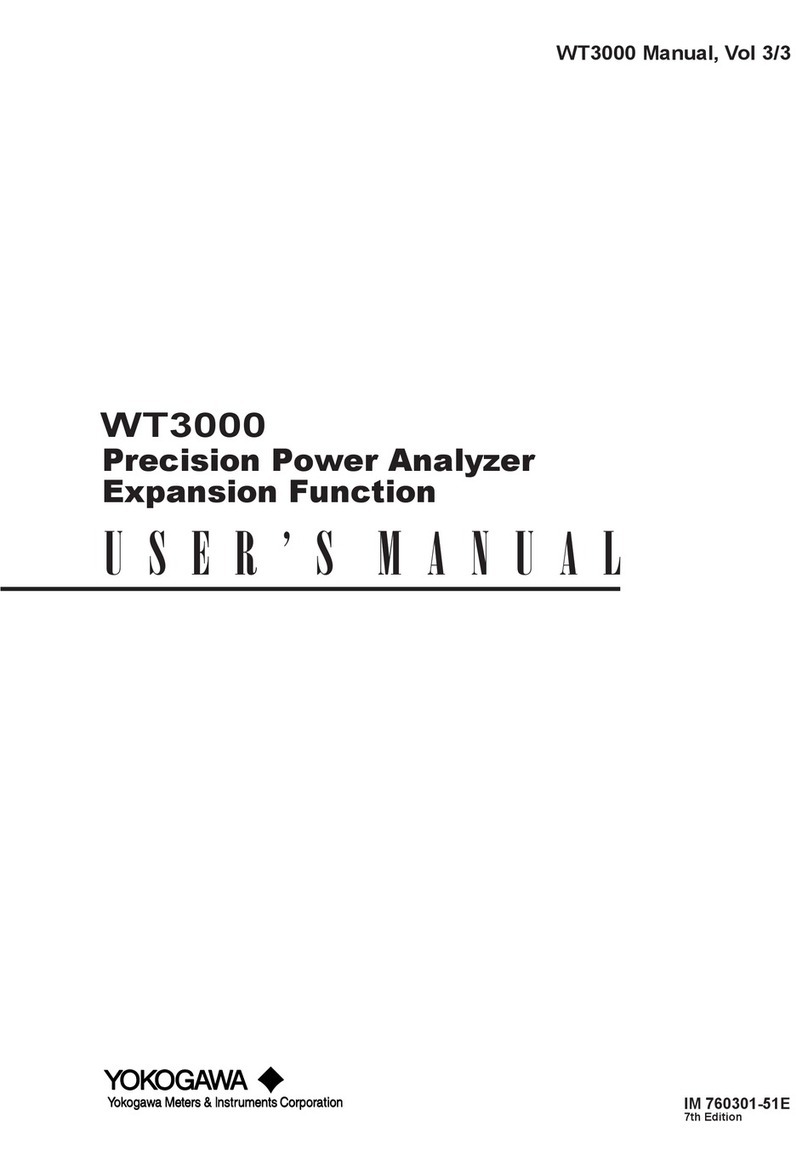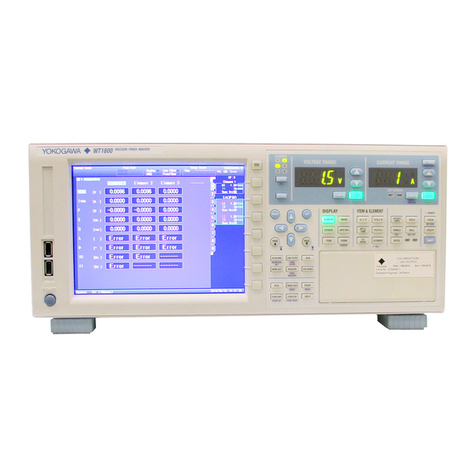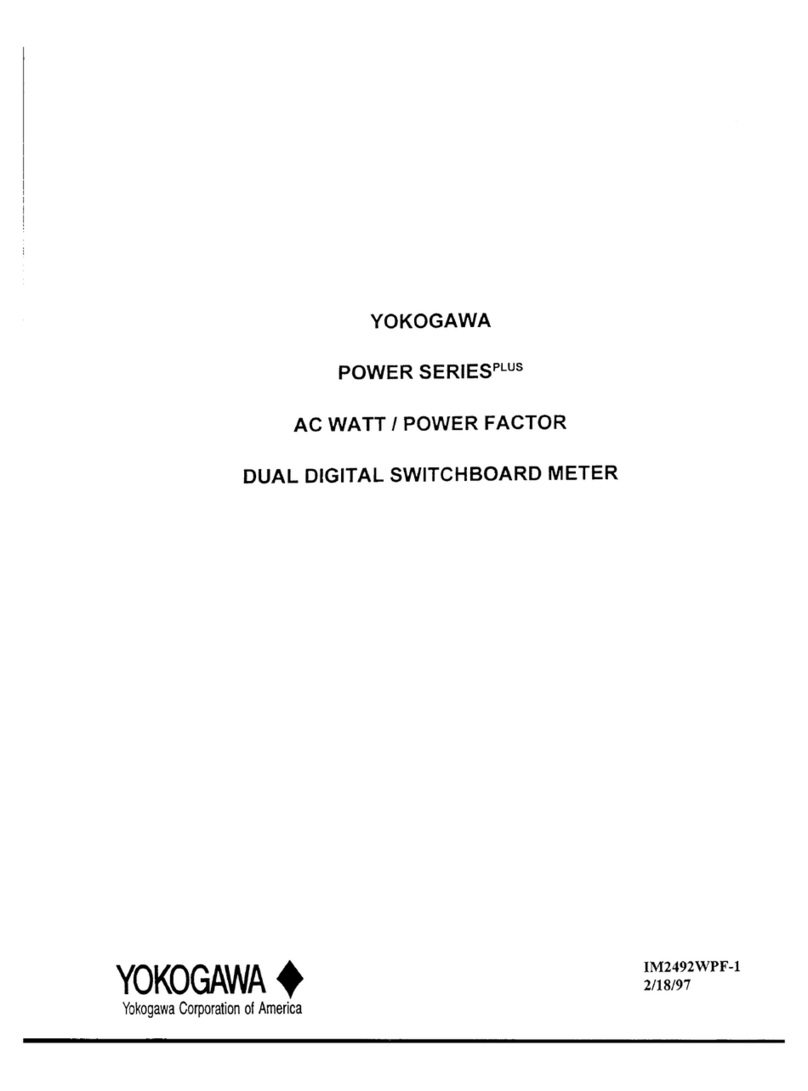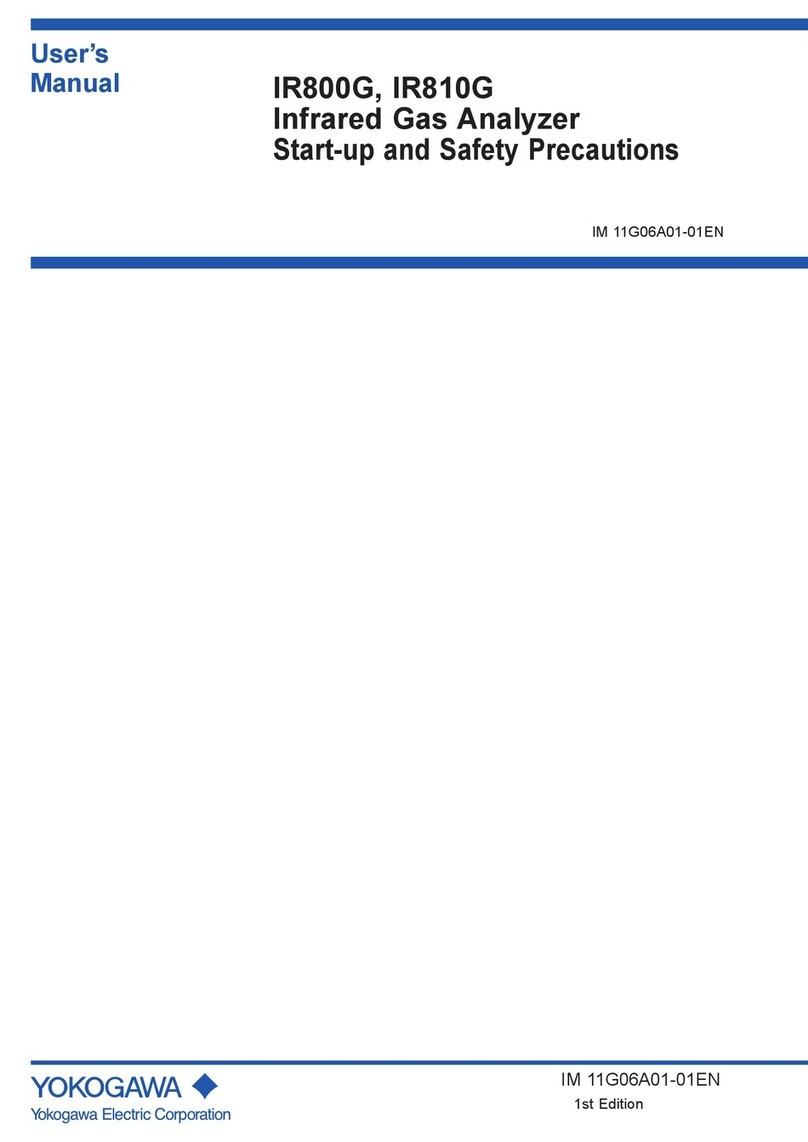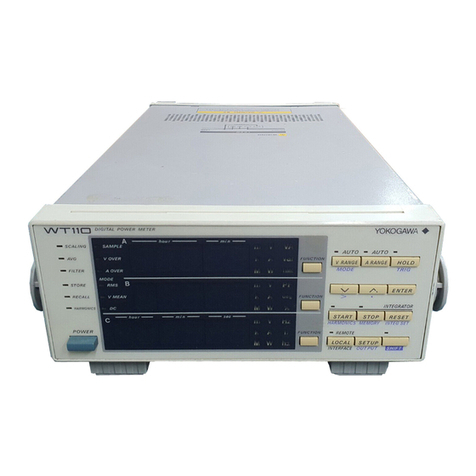
NOTE
CAUTION
CAUTION
NOTE
CAUTION
Black testing
lead
Red testing lead
Black testing lead
Figure 1
Figure 2
Red testing
lead
Black testing
lead
Red testing
lead Black testing
lead
/
4/10
Black testing lead
Red testing lead Black testing lead
Red testing lead
b)
c)
a)
F02:15 A/250 V
View with the Casing Open
F05:500 mA/250 V
AC Voltage Measurement
Accuracy (40-500 Hz)
CAUTION
IM 73201E<P2>
/
4/10
/
4/10
mA mA /
4/10
AA
*This function is not supported on the 73204 multimeter.
To avoid electrical shock!
To avoid electrical shock!
Do not mistake the following for a malfunction!
To avoid damage to instrument!
Do not mistake the following for a malfunction!
To avoid damage to Instrument or equipment.
protection fuse
protection fuse
Forward-biasDiode Test
Reverse-bias Diode Test
To replace the fuse(s):
a) Remove the three screws on the back
of the casing.
b) Open the casing.
c) Remove the blown fuse from
the fuse holder.
d) Install a new fuse in the holder.
e) Close the casing and fasten it with
the three screws.
Resolution
Resolution
Resolution
Voltage
Drop
Range
Range
Range
Maximum
Input Current
μA
mA
A
1%+2
2%+2
73201 73202 73203
400 μA
4000 μA
40 mA
400 mA
10 A *3
*2
*10.1 μA
1 μA
0.01 mA
0.1 mA
0.01 A
<0.17 mV/μA
<3 mV/mA
<0.04 V/A
DC Voltage Measurement V
A
Accuracy
Accuracy
Accuracy (40-500 Hz)
Input
Resistance
Input
Resistance
Maximum
Input Voltage
Maximum
Input Voltage
73201
732017320273203/04
73202/04 73203
0.3%+1
0.75%+1
0.75%+51%+5
0.5%+1
0.5%+1 600 V
600 V
10 MΩ
10 MΩ, <50 pF
11 MΩ, <50 pF
11 MΩ
>100 MΩ
0.1 mV
0.001 V
0.01 V
0.1 V
1 V
400 mV
4 V
40 V
400 V
600 V
Response: 1.5 sec maximum for 400 mV range or 1 sec maximum for other ranges
(Mean-value detection and rms-value calibration)
V
Response: 2 sec maximum
4 V
40 V
400 V
600 V
0.001 V
0.01 V
0.1 V
1 V
* This function is not supported on the 73204 multimeter.
DC Current Measurement
400 mA
The input is
protected by a
500 mA/250 V fuse
AUTO HOLD Function
The 732 series of multimeters can automatically retain the measured
value when the testing leads are handled as described below.
a) Press the AUTO.H key. (The display shows the symbol.)
b) Connect the testing leads to the object under test.
c) When the reading stabilizes, the buzzer sounds.
d) Remove the testing leads from the object under test.
e) The multimeter now shows the measured value that it retains.
f) You can repeat steps b) to e) as many times as you like as long as
the display shows the symbol.
A • H
A • H
g) To cancel this function, press the AUTO.H key once again.
(The symbol disappears.)
A • H
AUTO POWER OFF Function
The multimeter automatically turns off if no key is pressed for a period of
20 minutes. The multimeter will beep for approximately one minute to
alert the operator before the automatic power-off function takes effect.
(Pressing any key while the multimeter is beeping postpones the
power-off time. Pressing any key once after the power to the multimeter
is automatically turned off switches the multimeter on again.)
To cancel the automatic power-off function, hold down the SELECT key
and then set the function switch from the OFF to the position of any
desired measurement mode. (The AUTO POWER OFF indication turns
off when the function is canceled.)
To enable the function once again, temporarily switch the function switch
back to the OFF position, and then select the desired measurement mode.
Battery Replacement
If the batteries fall below the normal operating voltage, the symbol
turns on. If this happens, replace the batteries with new ones
(AAA-size [ANSI] batteries: 2 pcs.).
• Be sure to disconnect the multimeter from the circuit under test before replacing
the batteries.
• Replace both batteries at the same time making sure to position them with
the correct polarities.
Diode Test a) Set the function switch from the OFF position to
the position.
b) Plug the black testing lead into the COM input
terminal and the red testing lead into
the input terminal.
c) Connect the testing leads to the diode and then
read the multimeter when it stabilizes.
Capacitor Check
*This function is not supported on the 73201/04 multimeters.
d) When the test is complete, set the function
switch back to the OFF position and turn off
the multimeter.
(1) Forward-bias Diode Test
(2) Reverse-bias Diode Test
Connect the black testing lead to the cathode and
the red testing lead to the anode (see Figure 1).
Silicon diodes should give a reading of
approximately 0.5 V and light-emitting diodes a
reading between 1.5 V and 2.0 V.
Note that readings close to 0 V represent a
short-circuit and the "---" symbol indicates an
open-circuit.
Connect the black testing lead to the anode and
the red testing lead to the cathode (see Figure 2).
Normally, the display shows the "---" symbol,
indicating that the diode under test is normal.
The diode is defective if the display gives a
certain voltage level.
• Check to which mode the function dial is set before starting measurement.
• A current of 11 to 20 A can also be measured if the time interval is kept within
30 seconds. The buzzer will sound if the interval exceeds 30 seconds.
If this happens, immediately stop measurement.
To continue measurement, wait for 2 minutes or more when restart.
Current Measurement (μA/mA/A)
a) Set the function switch from the OFF position to either the μA, mA or A
position. (If the magnitude of the current being measured is not known,
select the A position.)
b) When measuring AC current, press the SELECT key to select the AC
mode. (The display shows the symbol to indicate AC-mode
measurement.)
c) Plug the black testing lead into the COM input terminal and
the red testing lead into the A input terminal.
If the current is in the order of milli-amperes or less,
plug the red testing lead into the input terminal.
d) Connect the testing leads to the circuit under test and then read the
multimeter when it stabilizes.
e) When measurement is complete, set the function switch back to the
OFF position and turn off the multimeter.
Zero calibration is only effective when the 20 nF range is selected.
Before starting measurement, be sure to discharge the capacitor under check.
a) Set the function switch from the OFF position to the
position.
b) Plug the black testing lead into the COM input terminal
and the red testing lead into the input
terminal.
c) Press the SELECT key to adjust the stray capacitance
to zero. (The display shows the CAL symbol)
d) Connect the testing leads to the circuit under check
and then read the multimeter when it stabilizes.
e) When measurement is complete, set the function
switch back to the OFF position and turn off the
multimeter.
CAL
• In DC voltage measurement, the AUTO HOLD function is only available for
ranges greater than the 4 V range.
• This function is not available for current-mode measurement.
• In a capacitor check, the AUTO HOLD function requires a few seconds before
it takes effect.
• The AUTO HOLD function cannot be applied to unstable signals.
To replace the batteries:
a) Remove the three screws on the back of
the casing.
b) Open the casing.
c) Take the battery holder out of the casing.
d) Replace the batteries with new ones and
install the battery holder back into the casing.
e) Close the casing and fasten it with the
three screws.
Fuse Replacement
If a current greater than the rated value flows when the multimeter is in the
current-measurement range, a protection fuse may blow. If this happens,
replace that fuse. The multimeter contains the following two types of fuses:
• Be sure to disconnect the multimeter from the circuit under test before replacing
the fuse(s).
• Do not operate the multimeter with the casing left open.
• In order to avoid damage to the multimeter or any possible accident,
use fuses of the specified rating.
• Type F05: 500 mA/250 V fuse
• Type F02: 15 A/250 V fuse
Specifications
1. General Specifications
2. Accuracy (Electrical Specification)
Measurement functions:
AC voltage, DC voltage, AC current (73201/02/03),
DC current (73201/02/03), resistance, continuity, diode and
capacitance (73202/03)
Additional functions: Auto hold, manual range selection,
over-range alarm, and Auto power off.
Display: LCD display that is capable of indicating a significant reading
of up to 4300* counts along with the indications of the unit and
function.
It shows the negative polarity only; no indication is given for
positive polarity.
The display also has the OL or over-range and
low-battery alarm indicators.
* : The most significant reading is 210 counts for the diode
test and 2300 counts for the capacitor check.
Range selection: Manual or automatic
Sampling: 2 times/sec
Operating temperature and humidity ranges:
0 to 50°C (Accuracy guaranteed range: 23±5°C)
Where the range is 0 to 40°C for humidity of 80%RH or less
and 40 to 50°C for humidity of 70%RH or less
Storage temperature and humidity ranges:
-20°C to 60°C, 70% RH or less
Battery life: Approximately 600 hours
(when continuously operated on alkaline batteries)
Power supply: AAA-size batteries (ANSI) . . . . . . . . 2 pcs.
External dimensions: Approx.74 (W) × 155 (H) × 31 (D) mm
(excluding protrusions)
Weight: Approx. 240 g (including batteries)
Safety standards: EN 61010-1: 2001, EN 61010-031: 2002+A1: 2008
AC/DC 300V CAT III, AC/DC 600 V CAT II
Indoor use, 2000m max above sea level,
Pollution degree2
EMC standards: EN 61326-1 Class B, EN 61326-2-2
EMC Regulatory Arrangement in Australia and
New Zealand
EN 55011 Class B Group 1
Korea Electromagnetic Conformity Standard
( 한국 전자파적합성기준 )
Effect of EMS immunity:
Accuracy range of reading: (Rated accuracy of each range) ×5
for the strength of a radio-frequency electromagnetic
field of 3 V/m
Accessories: Batteries . . . . . . . . . . . . . . . . . . . . . 2 pcs.
(housed in the instrument)
Testing leads . . . . . . . . . . . . . . . . . . . . 1set
Spare fuse:
F05 (500 mA/250 V) . . . . . . . . . . . . . . .1
F02 (15 A/250 V) . . . . . . . . . . . . . . . . . .1
User’s manual . . . . . . . . . . . . . . . . . . . . . .1
Capacitor check
Range Resolution Accuracy
73201/04 73202 73203
Response: 1 sec maximum
20 nF
200 nF
2 μF
20 μF
200 μF
0.01 nF
0.1 nF
0.001 μF
0.01 μF
0.1 μF
This function
is not
available.
Readings in the 20 nF
range are values after zero
calibration has been
completed.
Protection Fuse
By means of a
500 mA/250 V fuse
Response: 1 sec maximum
Diode Test
Range Resolution
2 V 0.01 V
Accuracy
73201/02/03/04 Open-circuit
Voltage
Open-circuit
Voltage
Input Protective
Voltage
Input Protective
Voltage
<3.4 V 600 V
(for measuring currents
smaller than 1.0 mA)
Continuity check
Range Resolution
400 Ω 0.1 Ω
Range of operation
73201/02/03/04
The buzzer turns on for
resistances lower than 50 ±20 Ω.
<3.4 V 600 V
Response: 0.2 sec maximum (for a buzzer response)
Resistance Measurement Ω
Response: 1 sec maximum for ranges lower than the 400 kΩ range,
5 sec maximum for the 4 MΩ range, and
15 sec maximum for the 40 MΩ range
Range Resolution Accuracy Measuring
Current
73201/02/03/04 Open-loop
Voltage Input Protective
Voltage
600 V
<3.4 V
<1.0 V
<0.7 V
<1.0 mA
<0.5 mA
<70 μA
<7 μA
<0.7 μA
<70 nA
0.75%+2
0.75%+1
2%+1
2%+5 (typical)
5%+2
1%+1
0.1 Ω
0.001 kΩ
0.01 kΩ
0.1 kΩ
0.001 MΩ
0.01 MΩ
400 Ω
4 kΩ
40 kΩ
400 kΩ
4 MΩ
40 MΩ
*2
*3
*1
(Mean-value detection and rms-value calibration)
* This function is not supported on the 73204 multimeter.
73201 73202 73203
Range Resolution Voltage
Drop Maximum
Input Current
A 10 A 0.01 A 2.5%+20 <0.04 V/A
mA
400 μA
4000 μA
40 mA
400 mA
0.1 μA
1 μA
0.01 mA
0.1 mA
2%+20
2%+5
2%+20
2%+5
<0.17 mV/μA
<3 mV/mA
400 mA
The input
is protected by a
500 mA/250V fuse
10A
The input is
protected by a
15 A/250 V fuse
*1, *2 These ranges may produce a readout error equivalent to several times their resolution.
*3 A current of 11 to 20 A can also be measured if the time interval is kept within 30 seconds.
The buzzer will sound if the interval exceeds 30 seconds.
Response: 2 sec maximum
10 A The input is
protected by a
15 A/250 V fuse
*1, *2 These ranges may produce a readout error equivalent to several times their resolution.
*3 A current of 11 to 20 A can also be measured if the time interval is kept within 30 seconds.
The buzzer will sound if the interval exceeds 30 seconds.
Response: 1 sec maximum
Conditions: 23 ±5°C at 80% RH or less
Accuracy: ±(% of reading + digits)
Note: Each response noted below is a value measured in
the Range Hold mode (manual range setting).
For the Pollution Control of Electronic and Electrical
Products of the People's Republic of China
This manual is valid only in China.
µA
有害物质
产品中有害物质的名称及含量
部件名称 铅 汞 镉 六价铬 多溴联苯 多溴二苯醚
(Pb) (Hg) (Cd) (Cr(VI)) (PBB) (PBDE)
电池 × × × × ○ ○
导线 × × × × ○ ○
线路板 ASSY × × × × ○ ○
框架(塑料) × × × × ○ ○
×: 表示该有害物质至少在该部件的某一均质材料中的含量超出GB/T 26572 规定的限量要求。
○: 表示该有害物质在该部件所有均质材料中的含量均在GB/T 26572 规定的限量要求以下。
该标识适用于SJ/ T11364中所述,在中华人民共和国销售的
电子电气产品的环保使用期限。
只要您遵守该产品相关的安全及使用注意事项,在自制造日
起算的年限内,则不会因产品中有害物质泄漏或突发变异,
而造成对环境的污染或对人体及财产产生恶劣影响。
注)
该年数为“环保使用期限",并非产品的质量保证期。
零件更换的推荐周期,请参照使用说明书。
环保使用期限 :
